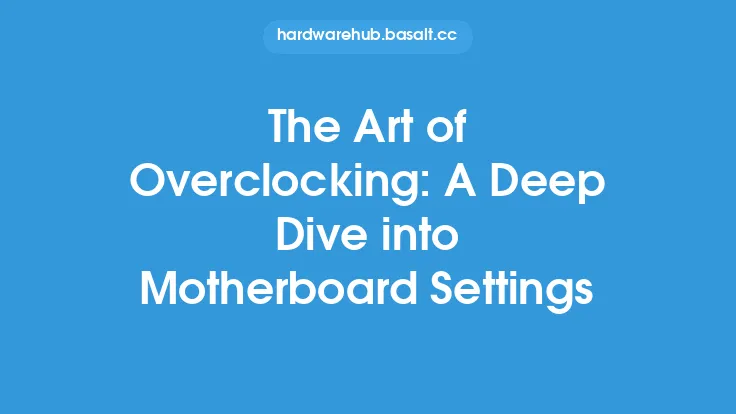The GPU geometry engine is a critical component of modern graphics processing units (GPUs), responsible for handling the complex geometric calculations required to render 3D graphics. At its core, the geometry engine is designed to process and transform 3D models, comprised of vertices, edges, and faces, into screen space coordinates that can be rasterized and displayed on a monitor. In this article, we will delve into the inner workings of the GPU geometry engine, exploring its architecture, key components, and the various stages involved in the geometric processing pipeline.
Introduction to Geometry Engines
The geometry engine is a specialized processing unit within the GPU, optimized for handling the unique demands of 3D graphics rendering. Its primary function is to take in 3D models, apply transformations, and output 2D screen space coordinates that can be further processed by the rasterization engine. The geometry engine is typically composed of several key components, including the vertex processor, the geometry processor, and the viewport transform unit. Each of these components plays a crucial role in the geometric processing pipeline, working together to ensure efficient and accurate rendering of 3D graphics.
Vertex Processing
Vertex processing is the first stage of the geometric processing pipeline, where the GPU geometry engine receives 3D vertex data from the application. The vertex processor is responsible for applying transformations to the vertex data, including translation, rotation, and scaling. This is typically achieved through matrix multiplications, where the vertex coordinates are multiplied by a series of transformation matrices to produce the final transformed vertex position. The vertex processor may also perform other tasks, such as vertex skinning, morphing, and attribute interpolation, to prepare the vertex data for further processing.
Geometry Processing
The geometry processor is the next stage of the pipeline, where the transformed vertex data is processed to generate new geometric primitives, such as points, lines, and triangles. The geometry processor is responsible for tasks such as primitive assembly, where individual vertices are combined to form geometric primitives, and primitive clipping, where primitives that lie outside the viewing frustum are discarded. The geometry processor may also perform other tasks, such as geometry instancing, where multiple instances of a geometric primitive are generated, and geometry tessellation, where complex geometric primitives are broken down into simpler ones.
Viewport Transformation
The viewport transform unit is the final stage of the geometric processing pipeline, where the transformed and processed geometric primitives are projected onto the 2D screen space. The viewport transform unit applies a series of transformations, including perspective division, viewport transformation, and scissor testing, to produce the final screen space coordinates of the geometric primitives. The resulting coordinates are then passed to the rasterization engine, where they are used to generate the final pixel values for display on the monitor.
Geometry Engine Architecture
The architecture of the GPU geometry engine is designed to optimize performance and efficiency in geometric processing. Modern geometry engines typically employ a combination of hardware and software components, including dedicated processing units, such as the vertex processor and geometry processor, and software-based solutions, such as vertex and geometry shaders. The geometry engine may also employ various techniques, such as parallel processing, pipelining, and caching, to improve performance and reduce latency.
Parallel Processing in Geometry Engines
Parallel processing is a key technique employed in modern GPU geometry engines to improve performance and efficiency. By processing multiple geometric primitives in parallel, the geometry engine can take advantage of the massive parallel processing capabilities of the GPU, reducing the time required to process complex geometric scenes. The geometry engine may employ various parallel processing techniques, including data parallelism, where multiple threads process different data elements in parallel, and task parallelism, where multiple threads execute different tasks in parallel.
Optimization Techniques for Geometry Engines
To optimize the performance of the GPU geometry engine, various techniques can be employed, including reducing the number of geometric primitives, using level of detail techniques to reduce complexity, and employing occlusion culling to discard primitives that are not visible. The geometry engine may also employ caching techniques, such as vertex caching and index caching, to reduce the time required to access and process geometric data. Additionally, the geometry engine may use various algorithms, such as the Bresenham line algorithm and the Sutherland-Hodgman clipping algorithm, to optimize geometric processing tasks.
Conclusion
In conclusion, the GPU geometry engine is a critical component of modern graphics processing units, responsible for handling the complex geometric calculations required to render 3D graphics. By understanding the architecture and key components of the geometry engine, as well as the various stages involved in the geometric processing pipeline, developers can optimize their applications to take advantage of the massive parallel processing capabilities of the GPU. By employing various techniques, such as parallel processing, caching, and optimization algorithms, developers can improve the performance and efficiency of their applications, enabling the creation of complex and realistic 3D graphics scenes.





